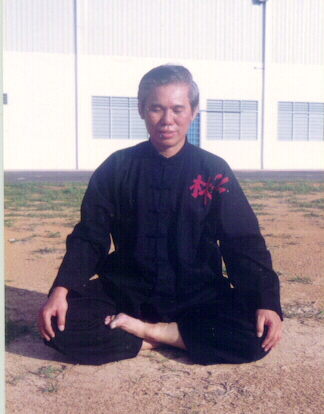WU WEI AND THE VOID

Students at the Intensive Chi Kung Course in Malaysia enjoying “Wu-Wei”
Wu Wei and the Void
“Once the ‘seed’ of the visualization has been planted in the depths of the sub-conscious mind and establishes a permanent ‘root’ there, the continued use of the visualization is no longer necessary as the deeper mind will perpetually work to manifest the visualization until it is similarly programmed to do otherwise.”
— Sifu Stier
Sifu Stier,
Here I think you are referring to the progression from “you wei” (conscious visualization) to “wu wei” (spontaneity). We also practice this in Shaolin Wahnam.
For example, in Dantian Breathing, we first “think of” breathing in good energy and breathing out negative energy. (“Think of” is another example of a word that can be substituted for the term “visualize”.) We do that about 3 or 4 out of 10 times. This 3 or 4 times thinking about the breathing process is “you we”. The other 6 or 7 times, when the desired breathing process goes on spontaneously, is “wu-wei”.
Amazingly, Sifu Wong's students learn to do this not at an advanced level, but often in their first year of practice! I think it's very kind (and wise) of Sifu not to keep secrets or make us wait until advanced levels for this. He allows students to experience “wu wei” even as beginners. And the results are amazing!
Both “you wei” and “wu wei” are significantly different from void meditation in Zen. So even spontaneous “wu wei” is still different from the void. Since, as you yourself mentioned, the visualization is still performed at the subconscious level even in “wu wei”, the meditation is still in the phenomenal realm. Thus, it is significantly different from Zen meditation, which is not in the phenomenal realm.
Phenomenal and Transcendental

Sifu Wong meditating on the Void in typical Zen meditation
I remember Sifu talking about his beloved master, Sigung Ho Fatt Nam. He said that Sigung Ho eventually turned to Zen because of the paradox of Taoist visualization. I think I've tasted pieces of this paradox in my own practice.
Visualization, even at the highest levels where it becomes spontaneous and subconscious (wu wei), still leads back to the phenomenal realm. Sifu said that a chi kung master can enjoy the Small Universal Flow without using conscious visualization, or build a pearl at dantian (the golden elixir) without using conscious visualization, or that a Taoist master might even roam heavenly realms as an Immortal - but these achievements, no matter how amazingly advanced, are still in the phenomenal realm.
Zen meditation on the void leads outside of the phenomenal realm to the transcendental realm. This is why Sigung Ho switched from Taoism to Zen.
More Similarities and Differences
At the supreme level, everything is the same. This is called different things by people using different approaches: Zen, Tao, Brahman, God, Allah, undifferentiated Energy, or simply Returning Home. But the key point is that the approaches are different.
The main approaches in Zen are meditation and gong-ans (koans). The main approaches in Taoism are meditation, spiritual sex, and golden pills. Zen cultivation does not make use of sex or pills. Taoist cultivation does not make use of gong-ans. Superficially, the only common factor is meditation.
But when we look deeper than the surface, we find a clear distinction even in that common factor! Typical Zen meditation aims at the void, whereas typical Taoist meditation makes extensive use of visualization. (Please note that I acknowledge that a few Zen practitioners also use visualization, and a few Taoist practitioners also aim at the void, but these are atypical and irrelevant to this discussion.)
Typically, Zen practitioners throughout history have aimed to return to Emptiness; Taoist practitioners have aimed to become Immortals. Returning to Emptiness is transcendental, whereas becoming an Immortal is still phenomenal. Both are worthy goals.
Some great Taoist masters also returned to Emptiness, symbolized by the three Supreme Taoist Deities: Lord of Cosmic Origin, Lord of Supreme Purity, and Lord of Supreme Void. But these are exceptional attainments, not typical Taoist attainments. On the other hand, a Zen cultivator aims at the Void right from the beginning. This is the Buddha's principle of “Directly pointing at the mind”.
Let me be clear: I am not saying that one tradition is better than the other. That would be silly since I benefit from both traditions. I am saying they are different. That is precisely why I practice both - to receive both of their benefits.
Nor am I saying that if you practice one tradition, you cannot practice the other. As mentioned earlier, while Shaolin Wahnam philosophy and practice is basically Zen, we also follow and benefit from Taoist philosophy and practice.
Indeed, we are lucky to have direct experience of both Zen and Taoist philosophies and practices. With direct experience of both practices, one can clearly see and feel the differences. This is what I mean when I say that there is a huge chasm between scholarly speculation and direct experience.
LINKS
Topics on Zen and Tao
- Zen is Zen, Tao is Tao
- Mistaking the word “Tao” for Taoism
- Zen Writings and Taoist Writings are Characteristically Different
- Simple in Language, Profound in Meaning
- Flowery Language in Buddhist Writings
- Symbolism in Zen Writings?
- A Parable — An Expedient Means for Spiritual Cultivation
- Yin-Yang and Non-Duality
- Wu Wei and the Void
- Zen and Tao
